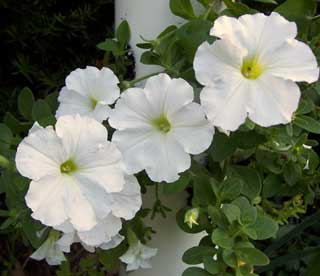I’m a Lonely Little Petunia in an Onion Patch
 The ubiquitous and often overlooked petunia is thought of by many gardeners as being a common bit of garden trash. They are so easy to grow and so darn everywhere, that many times we really feel that they are beneath us.
The ubiquitous and often overlooked petunia is thought of by many gardeners as being a common bit of garden trash. They are so easy to grow and so darn everywhere, that many times we really feel that they are beneath us.
But, a garden center would not be a garden center if it did not have a sea of multi-colored petunias waiting to be bought every spring by millions of non-gardeners who feel that they must plant them in order to keep up with their neighbors (who are are planting petunias just to keep up with them).
Petunias are originally South American. There are only two varieties that have been found in the wild, the white variety and the purple variety. Every petunia you see today, from the striped red petunia, to the double petunia to everything else between and beyond is descendant from these two flowers. This allows garden centers can say they offer a variety, when in fact, they offer the same two plants hybridized on a lunatic level.
The white petunia was retrieved by a party sent out by Napoleon. At this time, he had set himself up with quite an empire in Europe and had decided to see if there was anything worth plundering from Spanish held Argentina. His emissaries found a plant called “petun” by the locals and felt that it was a treasure to behold and sent some back.
Darwin on the other hand, though the places he visited on his infamous voyage were covered with the purple variety, he did not once mention them in his journals nor did he sent them back to Europe. Perhaps Darwin was destined to be reincarnated as a modern day gardener. Instead, it was an obsessed, senior citizen plant hunter named James Tweedie who had the honor of introducing the purple variety to the world.
Say what you will of the petunia, there is no denying that a significant portion of the horticultural industry relies on this little flower. I think suburbia may come to a screeching halt if petunias were suddenly to disappear from garden center shelves.
In case you had never heard the phrase I used as the title, it is from a song that came out several decades ago entitled “I’m a lonely little petunia in an onion patch“.
Some information for this article was taken from 100 Flowers and How They Got Their Names, by Diana Wells.
